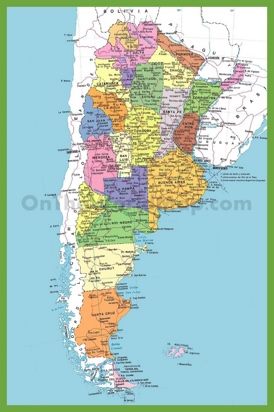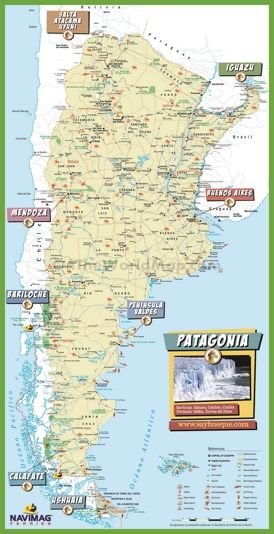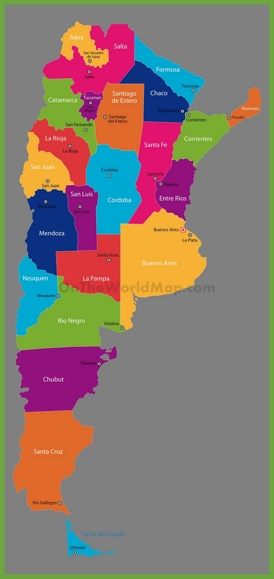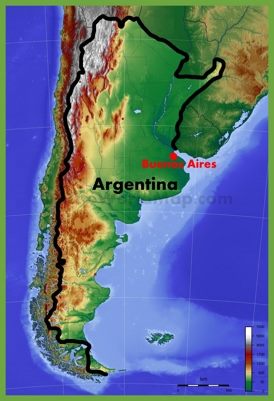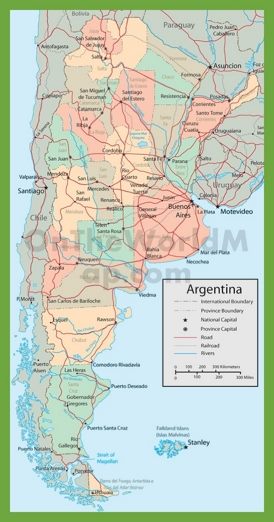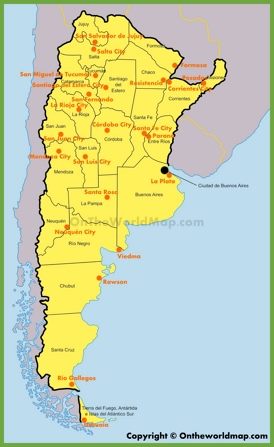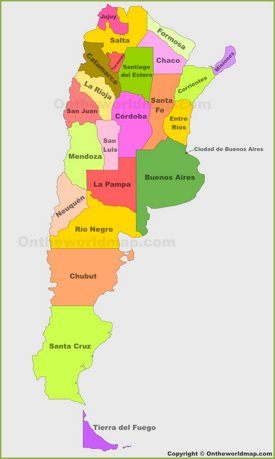Argentina Map
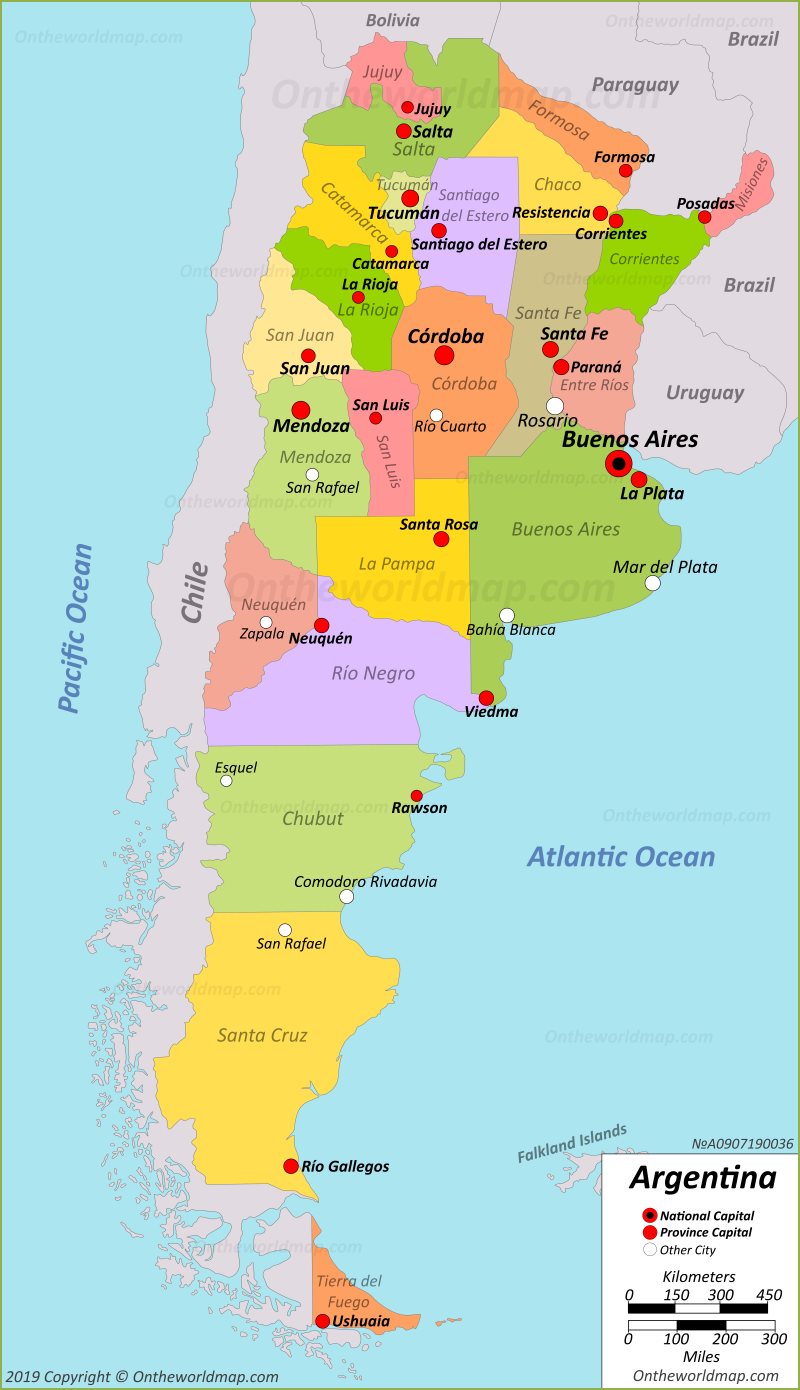
Description:
This map shows governmental boundaries of countries; provinces, province capitals and major cities in Argentina.
Size: 800x1390px / 151 Kb
Author: Ontheworldmap.com
You may download, print or use the above map for educational, personal and non-commercial purposes. Attribution is required. For any website, blog, scientific research or e-book, you must place a hyperlink (to this page) with an attribution next to the image used.
Online Map of Argentina
About Argentina
Argentina, located in the southern part of South America, is bordered by Chile to the west, Bolivia and Paraguay to the north, Brazil and Uruguay to the northeast. It is washed by the Atlantic Ocean to the east.
The capital, Buenos Aires, is the political, cultural, and economic center of the country. With a population of over 15 million, Buenos Aires is one of the largest cities in Latin America. Other major cities include Córdoba, Rosario, and Mendoza.
Argentina boasts a mixed economy characterized by a combination of agriculture, manufacturing, and services. The country is among the world's leading producers of soybeans, corn and wheat, and agriculture plays a key role in its export economy. Argentina also has a well-developed industrial base, including automotive, textiles and food processing. The service sector, especially finance and real estate, also contributes significantly to the country's GDP.
Tourism is the most important component of the Argentine economy, attracting millions of tourists every year. The country's diverse attractions range from the natural wonders of Patagonia and Iguazu Falls to the vibrant city life of Buenos Aires. The Andes Mountains offer skiing and mountaineering, while the Pampas region offers a taste of traditional Argentine ranch life. Argentina's wine regions, especially around Mendoza, are internationally recognized, further boosting tourism.
Cultural tourism is thriving in Argentina, with the music and dance of the tango serving as iconic symbols of the country's rich cultural heritage. Buenos Aires hosts numerous cultural festivals and events that attract both domestic and international tourists. The city's European architecture combined with a vibrant arts scene make it a center of cultural exploration.
Overall, Argentina is a dynamic country with a diverse economy and rich cultural attractions. Its strategic location and vibrant cities, as well as its strong agricultural base and booming tourism industry, make it an important player on the world stage. The country's combination of natural beauty and cultural richness continues to attract tourists and support its economic growth.
The Facts:
Capital: Buenos Aires.
Area: 1,073,500 sq mi (2,780,400 sq km).
Population: ~ 46,500,000.
Official language: Spanish.
Currency: Argentine peso ($) (ARS).
Largest cities: Buenos Aires, Córdoba, Rosario, La Plata, Mar del Plata, San Miguel de Tucumán, Salta, Santa Fe de la Vera Cruz, Vicente López, Corrientes, Pilar, Bahía Blanca, Resistencia, Posadas, San Salvador de Jujuy, Santiago del Estero, Paraná, Merlo, Neuquén, Quilmes, Banfield, Formosa, José C. Paz, Lanús, Godoy Cruz, Las Heras, La Rioja, Gregorio de Laferrère, Comodoro Rivadavia, San Luis, Ituzaingó, Berazategui, González Catán, Ezeiza, San Fernando del Valle de Catamarca, San Miguel, Río Cuarto, Concordia, Moreno, San Fernando de la Buena Vista, Ushuaia.
Provinces of Argentina: Autonomous City of Buenos Aires, Buenos Aires, Catamarca, Chaco, Chubut, Córdoba, Corrientes, Entre Ríos, Formosa, Jujuy, La Pampa, La Rioja, Mendoza, Misiones, Neuquén, Río Negro, Salta, San Juan, San Luis, Santa Cruz, Santa Fe, Santiago del Estero, Tierra del Fuego, Antártida e Islas del Atlántico Sur, Tucumán.
Driving side: right.
Calling code: +54.
Internet TLD: .ar.
Time zone: UTC−3 (ART).
Website: www.argentina.gob.ar.
Google Map of Argentina
Geography of Argentina
Argentina's geography encompasses a vast and diverse landscape of approximately 2.78 million square kilometers (1,073,500 sq mi). The country is divided into several distinct regions, each with unique geographical features and climates.
Along the country's western border stretch the Andes Mountains, which provide a dramatic backdrop and influence weather patterns. To the north, Gran Chaco has a subtropical climate characterized by hot, humid summers and mild winters.
The Pampas, a fertile lowland in central Argentina, serves as the agricultural center of the country with a temperate climate favorable to farming. The southern part of Patagonia contains arid steppes and rugged terrain with cooler temperatures and strong winds. This region also includes the Southern Andes, home to glaciers and snow-capped peaks.
Argentina's climate varies greatly from north to south. The north has a tropical and subtropical climate, while the central regions have a temperate climate with distinct seasons. Patagonia and Tierra del Fuego in the south have cooler temperatures and harsh conditions, and some areas have subpolar climates.
This geographic diversity supports a wide range of ecosystems and biodiversity, from subtropical forests to arid deserts, making Argentina a country of significant geographic interest.
Brief History of Argentina
Argentina's history is a complex mixture of indigenous cultures, colonial influences and political evolution. Indigenous peoples, including the Mapuche, Guaraní and Quechua, inhabited the region long before the arrival of Europeans. Spanish explorers arrived here in the early 16th century, establishing Buenos Aires as a key colonial settlement in 1580. Argentina remained part of the Spanish Empire until the early 19th century.
The May Revolution of 1810 began a period of struggle for independence, culminating in the Declaration of Independence on July 9, 1816. The nineteenth century saw the beginning of internal conflicts between federalists and unitarians that defined the political landscape of the country. In the late nineteenth and early twentieth centuries, waves of European immigration poured into the country and had a significant impact on Argentina's cultural and social fabric.
The 20th century saw periods of economic growth and political instability, including military coups and the return to democracy in 1983. The country has faced economic challenges, notably the 2001 financial crisis, but continues to play an influential role in regional and global affairs. Argentina's history testifies to its dynamic development and diverse cultural heritage.



